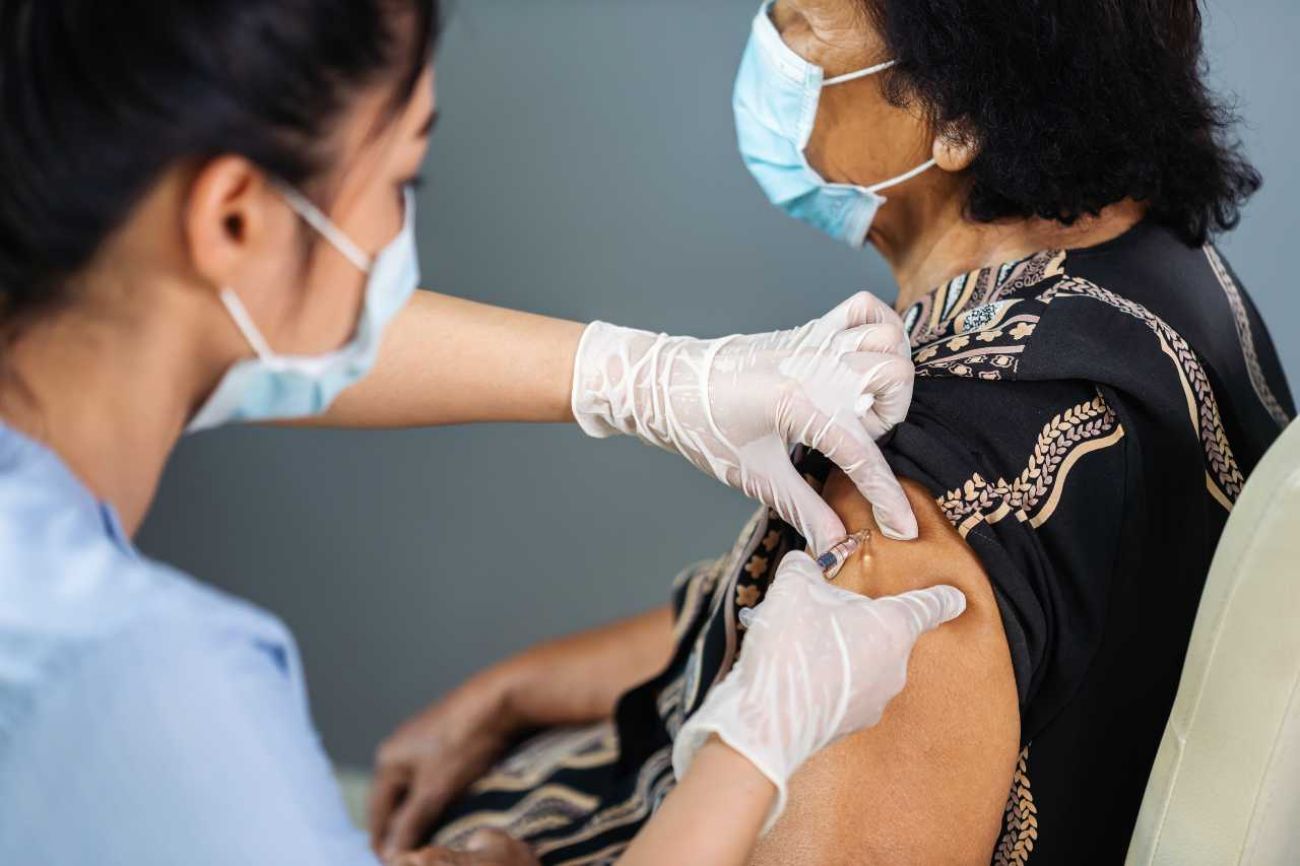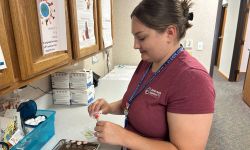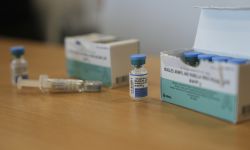Michigan health workers, senior facilities likely first for COVID vaccine

A vaccine for a COVID-weary state seemed to move closer to reality Tuesday.
Though any vaccine still must be approved by the U.S. Food and Drug Administration, a critical vote within another federal agency, would broadly urge states to give limited vaccines first to health care workers and nursing home residents, signalling that the vaccine might soon be available. The U.S. Centers for Disease Control and Prevention now will consider the recommendations.
Meanwhile, the state’s chief medical executive told Bridge Michigan Tuesday “a few hundred thousand” vaccines could arrive by next week for the state’s health care workers, though she stressed there are no guarantees. Among the hurdles: The two frontrunner vaccines, including one made at Pfizer’s Kalamazoo plant, still must obtain FDA approval — a possibility at a meeting of the Vaccines and Related Biological Products Advisory Committee (VRBPAC) on Dec. 10.
Related stories:
- COVID vaccine for Michigan health workers may arrive by next week
- Pfizer’s coronavirus vaccine is being made in Michigan
- Coronavirus is here. And Michigan’s public health system is underfunded.
- The latest: Michigan coronavirus unemployment, map, curve, updated COVID-19 news
- Dashboard: Michigan coronavirus testing numbers, trends, COVID-19 data
But also coming into focus is the enormity of the logistics that a mass vaccination campaign will require in Michigan and other states.
In Michigan, distributing vaccines quickly involves “incredibly complicated” logistics, Dr. Joneigh Khaldun, Michigan’s chief medical executive, told Bridge. Among the myriad questions state and local health officials must consider: Who gets vaccinated first — precisely which of the state’s roughly 600,000 health care workers, for example — while doses remain limited? How will the temperature-sensitive vials be safely stored and transported? Where will vaccination clinics be located? How will health leaders convince wary residents the vaccines are safe — despite its rush to develop?
And how best will the state’s health-care system staff up without knowing how much funding will be available to support Michigan’s vaccination push?
On Tuesday evening, the federal Advisory Committee on Immunization Practices Tuesday voted 13-1 to approve guidelines that prioritize health care workers and residents in long-term care facilities to be first in line for vaccines. (The committee considers staff in long-term care settings, such as nursing homes and assisted living centers, as health care workers.)
The committee works within the U.S. Centers for Disease Control and Prevention. Among the members that voted in favor of those guidelines was Michigander Veronica McNally, the committee’s consumer representative.
An attorney and public health advocate whose 12-week-old daughter died of pertussis in 2012, McNally said at the hearing she supported the ACIP guidelines for COVID distribution “after careful consideration of the science” as well as implementation consideration and the ethics of the decision.
In explaining the priorities list, Dr. Kathleen Dooley, of the CDC, said vaccinating health care workers offers a “multiplier effect” by preserving “health care capacity and better outcomes for all.”
It also “promotes justice,” in part, because health care staff “put themselves at risk and will be essential to carry out the vaccination program” and because health workers defined by the guidelines include “a broad range of occupations, inclusive of low-wage earners and racial and ethnic minority groups.”
Vaccinating residents of nursing homes and other long-term care residents “maximizes benefits by directly preventing disease in a high-risk group and minimizing harms by potentially reducing the burden on hospitals,” she said.
Committee Chair Jose Romero, who also is chief medical officer of the Arkansas Department of Health, supported the priorities list.
“We are using the principles of maximizing benefits and minimizing harm, promoting justice, and mitigating health inequities,” he said.
Still, the committee’s findings are guidelines only; states are not required to follow them. The granular work of distribution — once a vaccine is approved — will be led by the state’s hospitals, public health network, and organizations that serve vulnerable populations.
“People underestimate the magnitude of the operation,” said Arnold Monto, a national expert in infectious diseases at the University of Michigan School of Public Health.
Monto, who has studied coronaviruses for decades, will chair the FDA’s VRBPAC, the panel of advisers that meets Dec. 10.
Speaking in general about vaccine distribution and not the FDA’s approval process, Monto said the undertaking will be more comprehensive than even H1N1 flu vaccine efforts in 2009.
Distributing the much-anticipated coronavirus vaccine will be made all-the-more complicated by a lack of personnel and funding, he said.
Neither Congress nor outgoing President Trump have made clear how much federal funding will help with the effort. State budgets, meanwhile, have been hit hard this year as states try to grapple with the pandemic and its economic fallout. Michigan is expecting a budget shortfall of as much as $1 billion next year.
All this uncertainty follows years of disinvestment in public health.
Even before the first COVID-19 case was confirmed in the state in March, Michigan’s 45 public health departments were stretched thin. State funding for core health services had dropped 16 percent from an “inflation-adjusted high point of $300 million” in 2004, according to a 2018 report by the Citizens Research Council of Michigan, which analyzed Michigan’s public health funding dating to 2003.
“No one comes out against public health as a concept, but people generally pay attention to it only when there’s a crisis,” Tim Michling, a health policy research associate at the CRC and author of the report, told Bridge last spring. At the time of his comments, the number of deaths globally stood about 4,700.
By the end of this week, deaths in Michigan alone likely will be double that — a crisis that has kept public health workers scrambling to keep up with case investigations, contact tracing and testing events. Even as ACIP members met Tuesday, Michigan reported 190 additional COVID-19 deaths — the second highest single-day death toll since the pandemic began.
All this has stretched health departments ever thinner, requiring staff who typically conducted STD testing and educational programs in pre-pandemic times to redeploy in case investigations, contact tracing and testing events.
“Our public health teams and colleagues are tired,” said Nicholas Derusha, president of the Michigan Association of Local Public Health, which represents the state’s health departments. “They've been at this since March [with] many many folks working seven days a week.”
But, he added, mobilizing a mass vaccination effort is among the core areas of expertise for the state’s 45 local health departments: “We’ll get it done.”
“I feel like I’m getting hives,” Washtenaw County Health Department spokesperson Susan Ringler-Cerniglia said of the experience of planning to administer vaccines while so many questions remain unanswered.
“This is a whole ’nother health department primary responsibility, and how the heck are we going to do it with the same staff, the same people?” Ringler-Cerniglia said.
She and Steve Kelso, spokesman for the Kent County Health Department, said their agencies will have to staff up to handle all those duties at once. But it’s unclear how much money, if any, they’ll receive for such hiring.
“That money is going to have to come from somewhere,” Kelso said.
Additionally, they likely will have to work logistics on the fly, because they have precious little information about how much vaccine they can expect, or when.
In addition to the logistical worries, Kelso said he worries that news of a forthcoming vaccine will lull Michiganders into a false sense of security. Health departments, he said, will have to double down on messages reminding people that it’s still important to wear masks, avoid crowds, and take other precautions.
Because the two leading vaccines will each require two separate doses, Michigan’s health care system must also keep close track of which patients have received partial doses, and when they need to come in for a second shot.
Michigan’s plan calls for postcards from providers and text messages from the state to remind people when it’s time for their second vaccine dose.
A 64-page plan
Michigan’s draft vaccination plan, submitted to CDC in October for approval, envisions health care workers, including emergency medical service providers and hospital workers, receiving the first doses. As Bridge reported earlier Tuesday, the first shipment could arrive by next week — but only if all goes well with logistics. Precisely how many vaccines Michigan will get in its first batch is unclear, and estimates have fluctuated, Khaldun told Bridge.
As more doses become available — hopefully by January, Khaldun said during a press conference Tuesday — vaccination efforts will broaden to include workers and residents in other congregate settings, according to the state’s plan. Then come other health care workers, educators, and people at a particularly high-risk of developing severe illness if they contract COVID-19, Khaldun said.
The state will also prioritize other medically more vulnerable communities including people with underlying medical conditions, the elderly, those from racial and ethnic minority groups and tribal communities, those in correctional facilities, the homeless, those attending colleges and universities, those in rural communities, with disabilities, or those who are under- or uninsured.
Finally, eventually, comes the general public. It will likely be late spring before the average Michigander can access a vaccine, Khaldun said.
Vaccinations for children could come even later. Neither the Pfizer nor Moderna vaccine will be available for young children immediately.
Vaccination efforts are complicated by the fact that the Pfizer vaccine must be stored at -70 degrees Celsius, requiring special deep-freezers that many health care facilities currently lack.
As of now, Khaldun said, 48 hospitals and 12 local health departments in Michigan have the ultra-cold freezers needed to store the Pfizer vaccine. In addition, Khaldun said, more than 100 hospitals and health departments have the ability to store and distribute the Moderna vaccine, which doesn’t have to be stored at such cold temperatures.
Readying Michigan’s health care system to deploy the vaccine will be a massive undertaking that will likely involve staffing up and spending lots of money. In the absence of federal funding to support the effort, Whitmer has asked the Michigan Legislature to make state funds available.
In a Nov. 25 letter to legislative leaders, the governor sought $100 million in stimulus funding for Michigan’s unemployed residents and small businesses, and suggested a need for vaccine distribution funding. Republican Legislative leaders have said they expect to unveil their own relief package soon.
“We as a state need to step up and make this a priority now, so we’re ready when the vaccines are available,” Whitmer said Tuesday at a press briefing.
She did not say how much Michigan needs for the effort.
In addition to vaccines administered at hospitals and through the efforts of local health departments, Michigan’s plan envisions colleges as mass vaccination clinics.
Ted Montgomery, associate director of communications at Wayne State University in Detroit, said the university will vaccinate clinical students first. Once a vaccine is widely available, he expects vaccination to be mandatory for students who plan to spend any time on campus.
Montgomery said Wayne State could also “play a key role” in administering community vaccinations in Detroit, although it’s too early to know what that could look like.
Additionally, large pharmacy chains like CVS will also be crucial to Michigan’s immunization effort. Many of them are expected to receive vaccine supplies directly from the CDC to immunize people in long-term care facilities and, later, the general public.
Already, most of the state’s nursing homes and similar facilities have partnered with CVS and Walgreens pharmacies to eventually administer COVID vaccines to residents and staff, according to the Health Care Association of Michigan, which represents more than 350 long-term care facilities.
Its president and CEO, Melissa Samuel, called the impending vaccines “finally a sense of hope for the future.”
Bridge statehouse reporter Jonathan Oosting contributed to this report.
See what new members are saying about why they donated to Bridge Michigan:
- “In order for this information to be accurate and unbiased it must be underwritten by its readers, not by special interests.” - Larry S.
- “Not many other media sources report on the topics Bridge does.” - Susan B.
- “Your journalism is outstanding and rare these days.” - Mark S.
If you want to ensure the future of nonpartisan, nonprofit Michigan journalism, please become a member today. You, too, will be asked why you donated and maybe we'll feature your quote next time!








